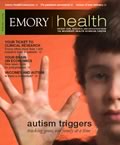An ounce of prevention
In the flu pandemic of 1918, Georgia's first recorded case was reported on October 19. Soon after, the Atlanta City Council temporarily closed all public gathering places, including schools, libraries, theaters, and churches. By the end of the year, thousands of additional cases were reported in Georgia, as were hundreds of deaths. Millions died worldwide.

Today scientists have a far better understanding of the flu virus and are working to prevent another pandemic. At Emory, two groups of researchers and their collaborators recently developed two approaches to lessen morbidity and mortality associated with flu during a normal season. Both strategies show promise in mitigating a worldwide outbreak.
The impact of vaccines
A new predictive epidemiologic model shows that giving infants the currently recommended 7 valent pneumococcal conjugate vaccine (PCV7) saves lives and money during a normal flu season by preventing related bacterial infections. According to the model, the vaccine would prevent more than 100,000 deaths during a flu pandemic, while saving $7 billion in costs. The PCV's effectiveness lies in its ability to prevent not only flu but also pneumococcal diseases,
such as pneumonia, meningitis, and ear infections.
We've known for years that bacterial infections can develop after influenza," says global health professor Keith Klugman at Emory's Rollins School of Public Health. "Unlike the 1918 flu pandemic, which preceded the antibiotic era, we now have vaccines that can prevent bacterial pneumococcal infections. This new model shows what a dramatically different outcome we could expect with standard PCV vaccination.;
Klugman and colleagues at Harvard University, i3 Innovus, and Wyeth Research constructed the model to estimate public health and economic impact of current pneumococcal vaccination practices in the context of a pandemic. The new predictive model compares using no PCV vaccination with the current routine of vaccinating infants under 2 years.
Our research shows that routine pneumococcal vaccination is a proactive approach that can greatly reduce the effects of a future flu pandemic," says Klugman. "Countries that have not yet implemented a pneumococcal vaccination program may want to consider this as part of pandemic flu preparedness."
|
Unlike the 1918 flu pandemic, which preceded the antibiotic era, we now have vaccines that can prevent bacterial pneumococcal infections. --Keith Klugman, global health professor, Rollins School of Public Health |
||||
Speedy antibodies
Conversely, should a flu pandemic occur, doctors now have a faster way to create human monoclonal antibodies against the virus. This technique taps the immune system at the peak of its powers and could be used either as a stopgap therapy or to protect people from infection.
Researchers from Emory's medical school and the Oklahoma Medical Research Foundation report that during an outbreak, human monoclonal antibodies can be put into action within a month. Furthermore, the method could find broad application toward almost any infectious disease.
Previously, methods for making human monoclonal antibodies have been laborious, says Rafi Ahmed, director of the Emory Vaccine Center and a Georgia Research Alliance Eminent Scholar. They involved sifting through human B cells to find those that made the right antibodies or vaccinating mice to "humanize" the mouse antibody genes (altering them so they resemble human antibodies).
In the new approach, the researchers isolated antibody-secreting plasma cells from the blood of volunteers a week after flu vaccination. They then cloned the antibody genes from these antibody-secreting cells.
"There's a transient window where the cells that are making high-quality antibody are found in the blood," Ahmed says. "They disappear from the blood afterwards, but at a certain point, most of the antibody-secreting cells are making antibody specific for flu virus."
"With just a few tablespoons of blood, we can now rapidly generate human antibodies that can be used for immunization, diagnosis, and treatment of newly emerging strains of influenza," says Oklahoma collaborator Patrick Wilson. "In the face of a disease outbreak, the ability to quickly produce infection-fighting human monoclonal antibodies would be invaluable."
Editor's note: Keith Klugman's research was funded by Wyeth Research, and he is a paid consultant for Wyeth Pharmaceuticals.


